Research on Sound Transmission Characteristics of Shell-And-Tube Heat Exchangers Based on TPMS Structures
Abstract
1. Introduction
2. Structural Design of Shell-And-Tube Heat Exchanger Integrated with TPMS Structures
2.1. Subsection
2.2. Design of TPMS-Structured Heat Exchanger
3. Analysis and Discussion
3.1. Analysis Method
3.2. Effect of Unit Cell Type on the Transmission Loss Performance of the TPMS-Structured Heat Exchanger
3.3. Effect of Unit Cell Size on the Acoustic Transmission Performance of the TPMS-Structured Heat Exchanger
3.4. Effect of Volume Fraction on the Transmission Loss Performance of Heat Exchangers
4. Comparison with the Sound Insulation Effect of STHE
5. Conclusions
- (1)
- The influence of the TPMS unit cell type on the acoustic transmission characteristics of the TPMS-structured heat exchanger is primarily related to the geometry of the fluid domain isolated by the unit cell type. Among the four types—Gyroid, Split P, Schwarz D, and Schwarz P—the porosity varies only slightly with changes in volume fraction. The fluid domain channels of the first three types are relatively straight, whereas the fluid domain of the Schwarz P type can be regarded as a multi-stage series of expansion tube mufflers along the central axis of the heat exchanger. As a result, its sound insulation performance is particularly outstanding. The frequency range in which its sound insulation performance excels is mainly related to the length and volume of the fluid cavities considered as expansion tubes.
- (2)
- Increasing either the volume fraction or the unit cell size can enhance the sound insulation capability of the TPMS-structured heat exchanger. An increase in volume fraction means that less energy from the sound waves penetrates the heat exchanger core, correspondingly increasing reflection. Increasing the unit cell size, on the other hand, implies an increase in porosity, allowing more sound waves to enter the low-temperature fluid channels. This alters the scattering characteristics and reflection paths of the sound waves, reducing reflected energy and enhancing the geometric structure’s dissipation of sound waves. Therefore, to achieve excellent sound insulation performance, one of these parameters can be increased. In practice, increasing the unit cell size is a more convenient way to achieve good sound insulation performance compared to increasing the volume fraction. For example, for Gyroid type TPMS heat exchangers with a = 100 mm and a = 200 mm, at RD = 30% and 40%, the transmission loss (TL) values are 27.67 dB (100 mm, 30%), 28.95 dB (100 mm, 40%), 32.03 dB (200 mm, 30%), and 33.32 dB (200 mm, 40%), respectively.
- (3)
- The results compared with experimental data from shell-and-tube heat exchangers indicate that, in a water medium, due to the wavelength of sound waves, despite the complex channel variations in the TPMS structure, it remains ineffective at blocking sound wave transmission in the 1700–3000 Hz frequency range, except for the Schwarz P type structure. This study suggests that, to achieve good sound insulation performance underwater, the geometric structure of the TPMS should possess the geometric characteristics of reactive mufflers.
Author Contributions
Funding
Institutional Review Board Statement
Informed Consent Statement
Data Availability Statement
Conflicts of Interest
Abbreviations
| TPMS | Triply Periodic Minimal Surface |
| STHE | Shell-and-Tube Heat Exchangers |
| FEM | Finite Element Method |
| AS | Analytical Solutions |
References
- Liu, X.X. Study on Noise Characteristics of Marine Seawater Piping System. Master’s Thesis, Huazhong University of Science and Technology, Wuhan, China, 2022. [Google Scholar]
- Wu, H. Analytical Calculation and Experimental Study on Acoustic Performance of Water Pipe Silencer. Master’s Thesis, Harbin Engineering University, Harbin, China, 2023. [Google Scholar]
- Gong, J.F.; Jiang, Z.Y.; Yuan, X.J.; Xuan, L.K. Analysis of acoustic attenuation performance of shell and tube heat exchangers. J. Huazhong Univ. Sci. Tech. (Nat. Sci. Ed.) 2020, 48, 55–60. [Google Scholar]
- Zhang, Z.T.; Qin, Z.M.; Bao, C.H.; Hou, L.F.; Sun, K.J.; Long, X.P. Experiment on the noise reduction performance of gas-water cabin in the pipeline system of underwater vehicle. J. Natl. Univ. Def. Technol. 2024, 46, 137–149. [Google Scholar]
- Fu, Q. Study on Sound Insulation Property of Sandwich Composite Aluminum Foam Based on COMSOL. Intern. Combust. Engine Parts 2023, 86–88. [Google Scholar] [CrossRef]
- Karim, S.; Atef, M.; Marwan, H. Experimental Study on Damping Acoustic Pressure Pulsations in Pipeline Systems Using Helmholtz Resonators. J. Press. Vessel Technol. 2019, 142, 021403. [Google Scholar]
- Huang, Y.; Yan, B.; Zhang, H.; Wang, C.; Wang, J.; Zhang, Z.; Huang, Q.; Zhan, X. Transmission Loss Characteristics of Dual Cavity Impedance Composite Mufflers for Non-Planar Wave Cavity Resonance. Appl. Sci. 2024, 14, 6879. [Google Scholar] [CrossRef]
- Hou, J.X.; Zhu, H.C.; Mao, R.F. Theoretical analysis on the transmission loss of a micro-perforated tube muffler with gradually changed back cavity. J. Vib. Shock 2019, 38, 189–194. [Google Scholar]
- Lawrie, J.B.; Guled, I.M. On tuning a reactive silencer by varying the position of an internal membrane. J. Acoust. Soc. Am. 2006, 120, 780–790. [Google Scholar] [CrossRef]
- Hou, J.X.; Zhu, H.C.; Yuan, S.W.; Liao, J.L. Transmission loss of flexible micro-perforated muffler with fexible back cavity for water filled pipelines. Acta Acoust. 2021, 46, 405–414. [Google Scholar]
- Hou, J.X.; Zhu, H.C.; Liao, J.L.; Yuan, S.W. Sound absorption characteristics of underwater flexible micro-perforated sound absorption structure. Acta Acoust. 2021, 46, 135–142. [Google Scholar]
- Li, H.D.; Zhang, Q.Q.; Yang, L.; Akram, N.; Chang, C.L.; Mo, W.L.; Shen, W.F. Detailed design of shell-and-tube heat exchanger using intelligent evolutionary algorithms. CIESC J. 2025, 76, 241–255. [Google Scholar]
- Wang, Y.; Liu, T.; Sha, J.; Ren, H. Large eddy simulation-based analysis of the flow-induced noise characteristics of shell and tube heat exchanger. Int. Commun. Heat Mass Transf. 2023, 148, 107030. [Google Scholar] [CrossRef]
- Elsayed, A.; Bastien, C.; Jones, S.; Christensen, J.; Medina, H.; Kassem, H. Investigation of baffle configuration effect on the performance of exhaust mufflers. Case Stud. Therm. Eng. 2017, 10, 86–94. [Google Scholar] [CrossRef]
- You, C.X.; Pei, Z.X.; He, X.S. Simulation of Acoustic Performance of Submarine Heat Exchanger with Noise Silencing Function. Zaochuan Jishu 2024, 52, 47–54. [Google Scholar]
- Gustafsson, O.; Stignor, C.H.; Dalenbäck, J.O. Heat exchanger design aspects related to noise in heat pump applications. Appl. Therm. Eng. 2016, 93, 742–749. [Google Scholar] [CrossRef]
- Cao, Y.; Ke, H.; Lin, Y.; Zeng, M.; Wang, Q. Investigation on the flow noise propagation mechanism in pipelines of shell-and-tube heat exchangers based on synergy principle of flow and sound fields. Appl. Therm. Eng. 2017, 122, 339–349. [Google Scholar] [CrossRef]
- Niknam, S.A.; Mortazavi, M.; Li, D.S. Additively manufactured heat exchangers: A review on opportunities and challenges. Int. J. Adv. Manuf. Technol. 2021, 112, 601–618. [Google Scholar] [CrossRef]
- Han, L.; Che, S.N. An overview of materials with triply periodic minimal surfaces and related geometry: From biological structures to self-assembled systems. Adv. Mater. 2018, 30, e1705708. [Google Scholar] [CrossRef]
- Izard, A.G.; Bauer, J.; Crook, C.; Turlo, V.; Valdevit, L. Ultrahigh energy absorption multifunctional spinodal nanoarchitectures. Small 2019, 15, e1903834. [Google Scholar] [CrossRef]
- Al-Ketan, O.; Al-Rub, R.K.A. MSLattice: A free software for generating uniform and graded lattices based on triply periodic minimal surfaces. Mater. Des. Process. Commun. 2021, 3, e205. [Google Scholar] [CrossRef]
- Zhuang, X.X.; Xiong, Z.X.; Guo, H.; Sun, Z.Y.; Zhao, L.X. Analysis of the sound insulation performance of triply periodic minimal surface acoustic metamaterials. J. of Appl. Acoust. 2024, 1–9. Available online: https://kns.cnki.net/kcms2/article/abstract?v=0eC8MkjONMG4BZFYtZ6I5b9JdkPyYjJtcVwzYfPuPsDjcsY8TFEi4Q1pzIW-MgbM_JL8pwQTQDeS1EJVfIpHe7ftsRv0p7J6QT-fQyePNXysOpe9o5QSv1OQS5L12XsqmxVoLqJXiY8xInxcNWpyiMDyte4-PLvQWi9aDm5AreRjxgm7smHOlw==&uniplatform=NZKPT&language=CHS (accessed on 7 November 2025).
- Chen, Y.Y.; Wang, L.F. Periodic co-continuous acoustic metamaterials with overlapping locally resonant and bragg band gaps. Appl. Phys. Lett. 2014, 105, 191907. [Google Scholar] [CrossRef]
- Abueidda, D.W.; Jasiuk, I.; Sobh, N.A. Acoustic band gaps and elastic stiffness of PMMA cellular solids based on triply periodic minimal surfaces. Mater. Des. 2018, 145, 20–27. [Google Scholar] [CrossRef]
- Lu, J.-Y.; Silva, T.; Alzaabi, F.; Abu Al-Rub, R.K.; Lee, D.-W. Insights into acoustic properties of seven selected triply periodic minimal surfaces-based structures: A numerical study. J. Low Freq. Noise Vib. Act. Control 2024, 43, 208–219. [Google Scholar] [CrossRef]
- Hur, K.; Hennig, R.G.; Wiesner, U. Exploring Periodic Bicontinuous Cubic Network Structures with Complete Phononic Bandgaps. J. Phys. Chem. C 2017, 121, 22347–22352. [Google Scholar] [CrossRef]
- Tan, P.; Fu, T.; Li, F.C.; Jiang, J.F.; Wang, H. Low-frequency broadband acoustic absorption properties of triply periodic minimal surface acoustic metamaterials. Acta Mater. Compos. Ainica 2024, 42, 2928–2941. [Google Scholar]
- Sysoev, E.I.; Sychov, M.M.; Shafigullin, L.N.; Dyachenko, S.V. Design of Sound Absorbing Honeycomb Materials with a Geometry of Triply Periodic Minimal Surfaces (TPMS). Acoust. Phys. 2024, 70, 887–898. [Google Scholar] [CrossRef]
- Silva, T.; Lu, J.-Y.; Abu Al-Rub, R.K.; Lee, D.-W. Investigation on tailoring the width and central frequency of bandgaps of TPMS structures. Int. J. Mech. Mater. Des. 2024, 20, 317–329. [Google Scholar] [CrossRef]
- Iyer, J.; Moore, T.; Nguyen, D.; Roy, P.; Stolaroff, J. Heat transfer and pressure drop characteristics of heat exchangers based on triply periodic minimal and periodic nodal surfaces. Appl. Therm. Eng. 2022, 209, 118192. [Google Scholar] [CrossRef]
- Cheng, Z.L.; Xu, R.N.; Jiang, P.X. Morphology, flow and heat transfer in triply periodic minimal surface based porous structures. Int. Lournal Heat Mass Transf. 2021, 170, 120902. [Google Scholar] [CrossRef]
- Li, W.H.; Gao, G.Y.P.; Yu, Z.B. Bioinspired heat exchangers based on triply periodic minimal surfaces for supercritical CO2 cycles. Appl. Therm. Eng. 2020, 179, 115686. [Google Scholar] [CrossRef]
- Gajetti, E.; Boccardo, G.; Savoldi, L.; Marocco, L. Hydrodynamic characterization of Gyroid, Diamond and Split-P Triply Periodic Minimal Surfaces as porous medium. Int. J. Heat Mass Transf. 2025, 252, 127439. [Google Scholar] [CrossRef]
- Feng, X.D.T.; Li, X.D.; Liu, K. Computation of total transfer matrix in serial-connection expansion tubes. Tech. Acoiustics 2009, 28, 231–232. [Google Scholar]
- Liu, G.M.; Wang, X.; Zhao, X.C.; Kong, D.Y. Research on Transmission Loss Measurement of Water Mufflers Based on a Thick-Walled Pipe Test Bench. In Proceedings of the 16th Academic Conference on Ship Underwater Noise, Guiyang, China, 22 August 2017. [Google Scholar]

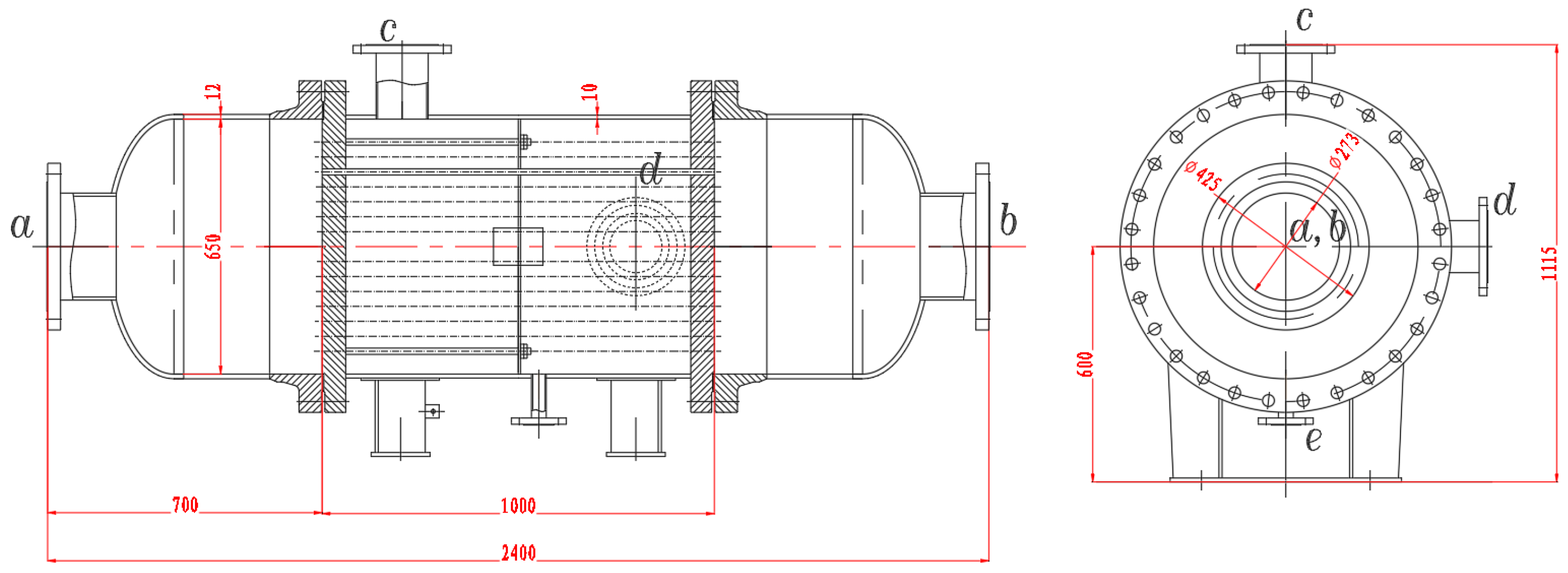

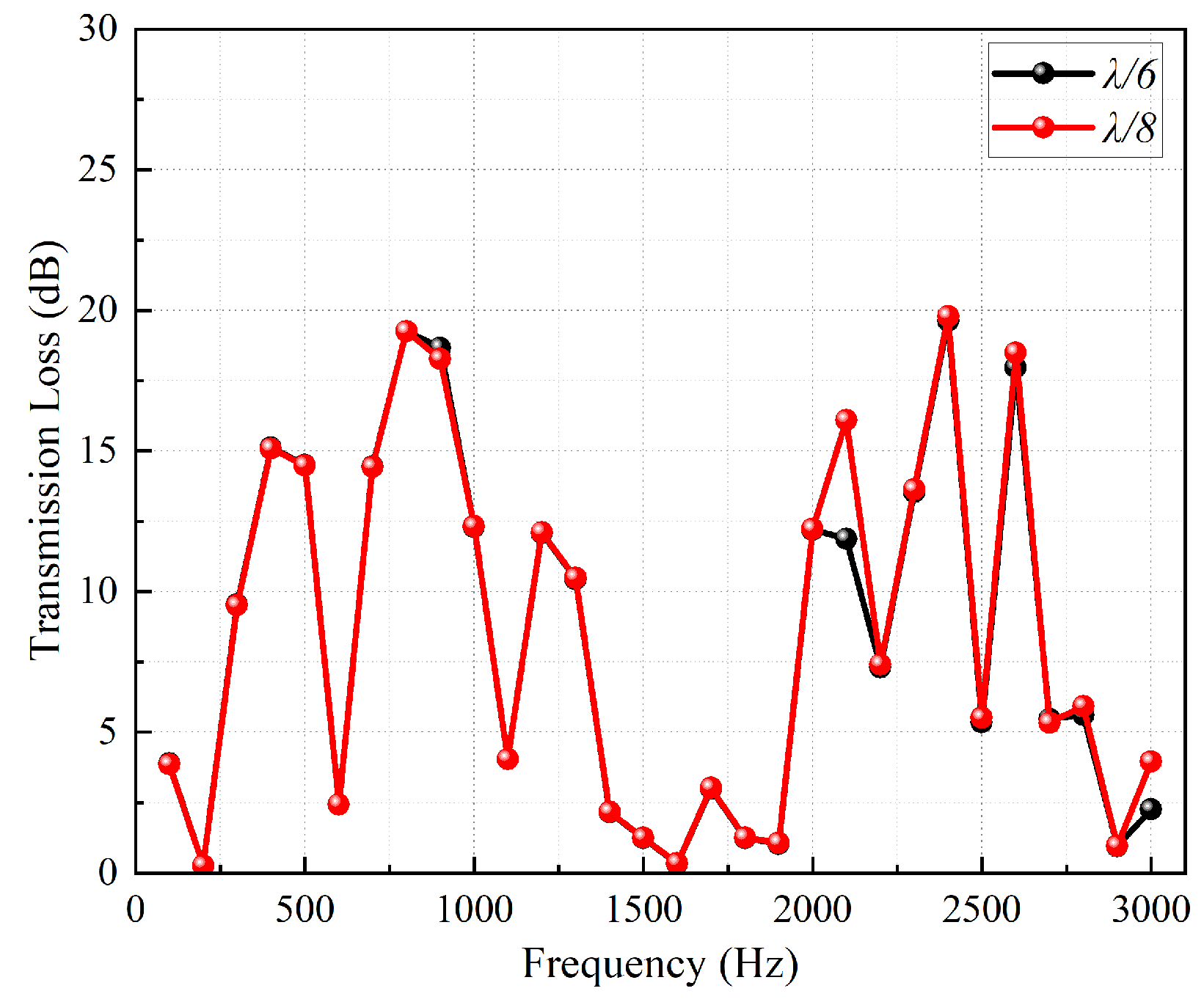

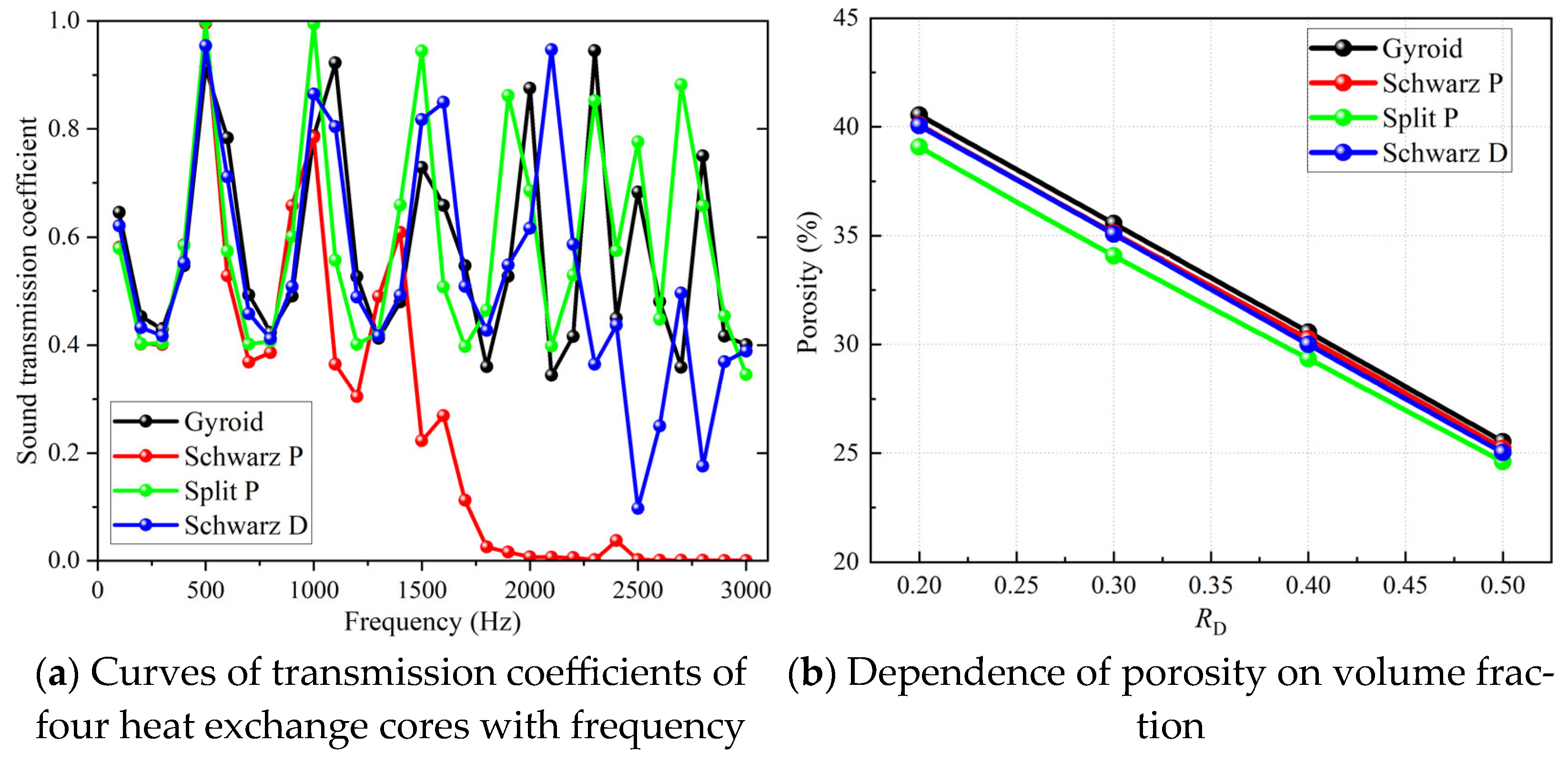
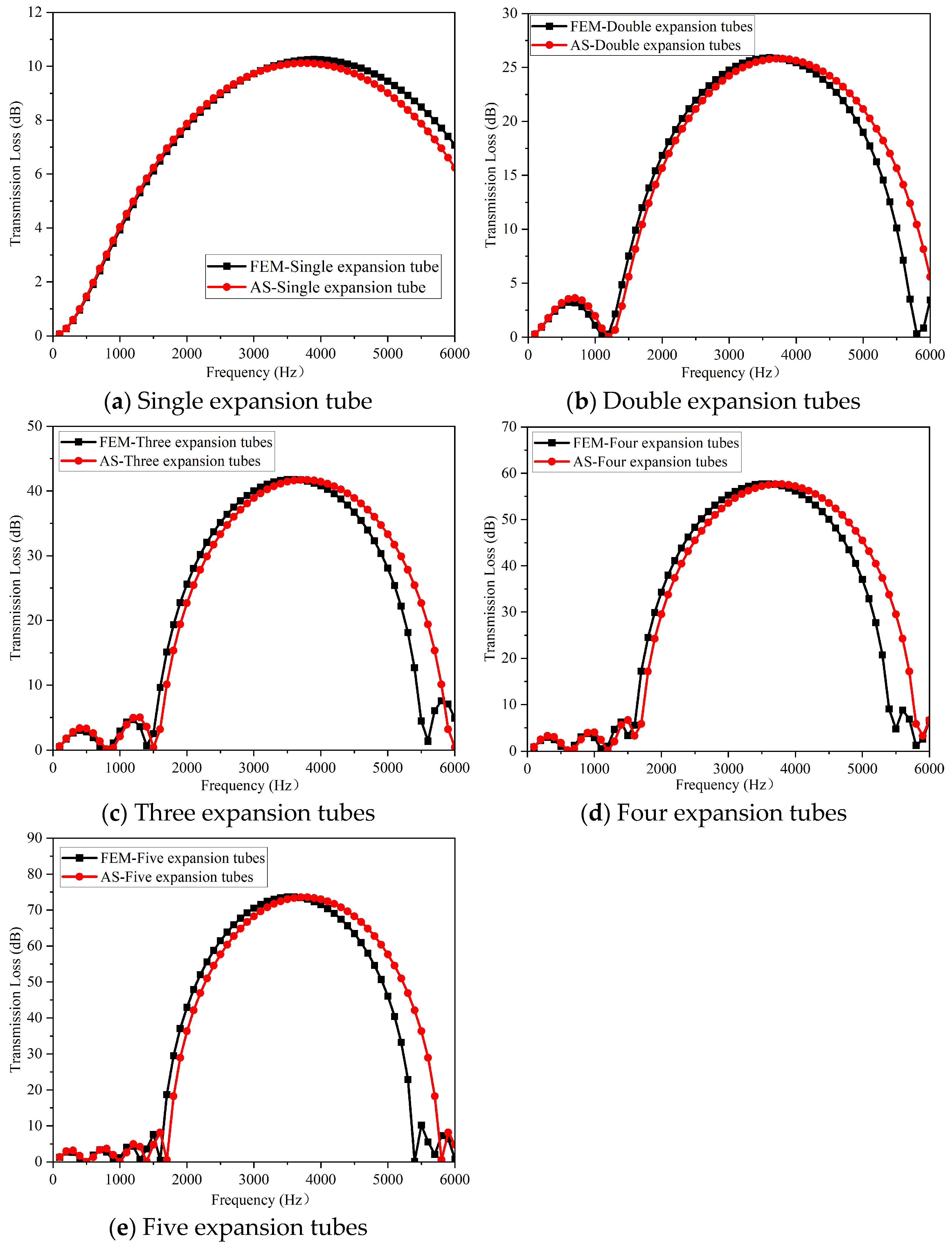
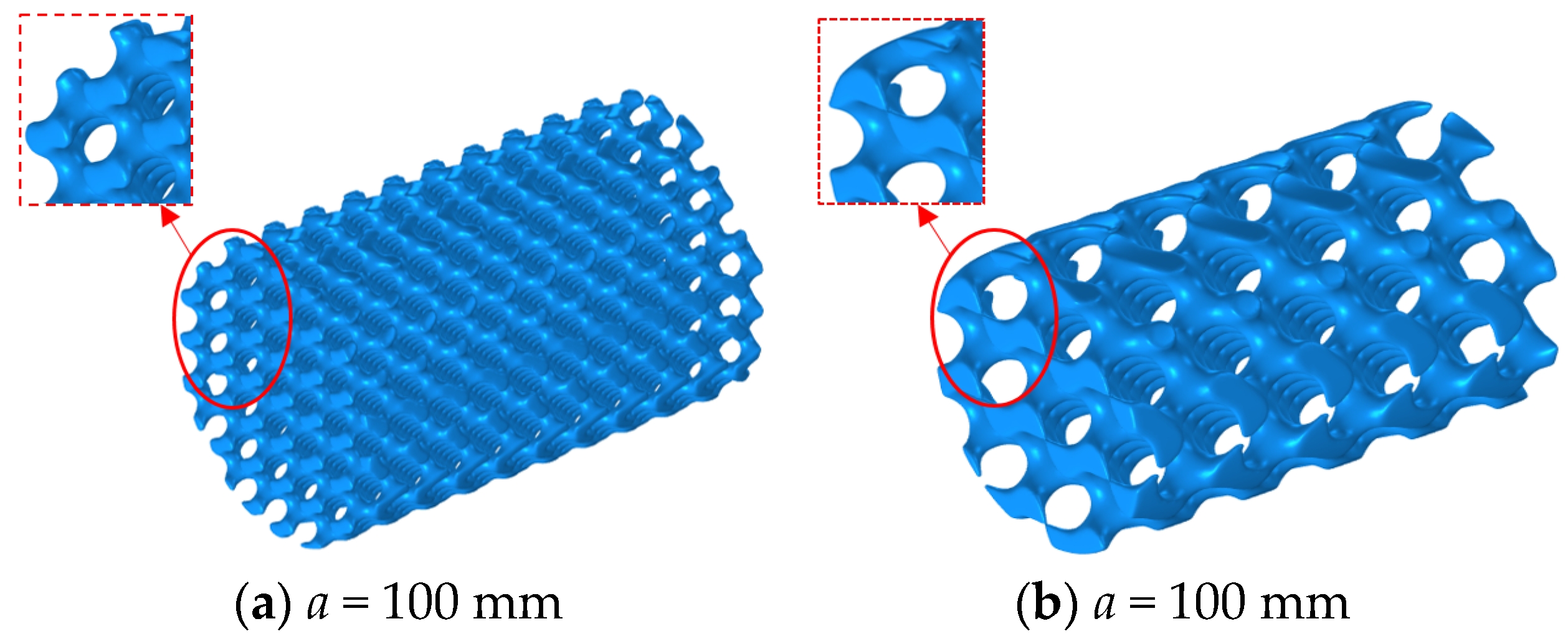

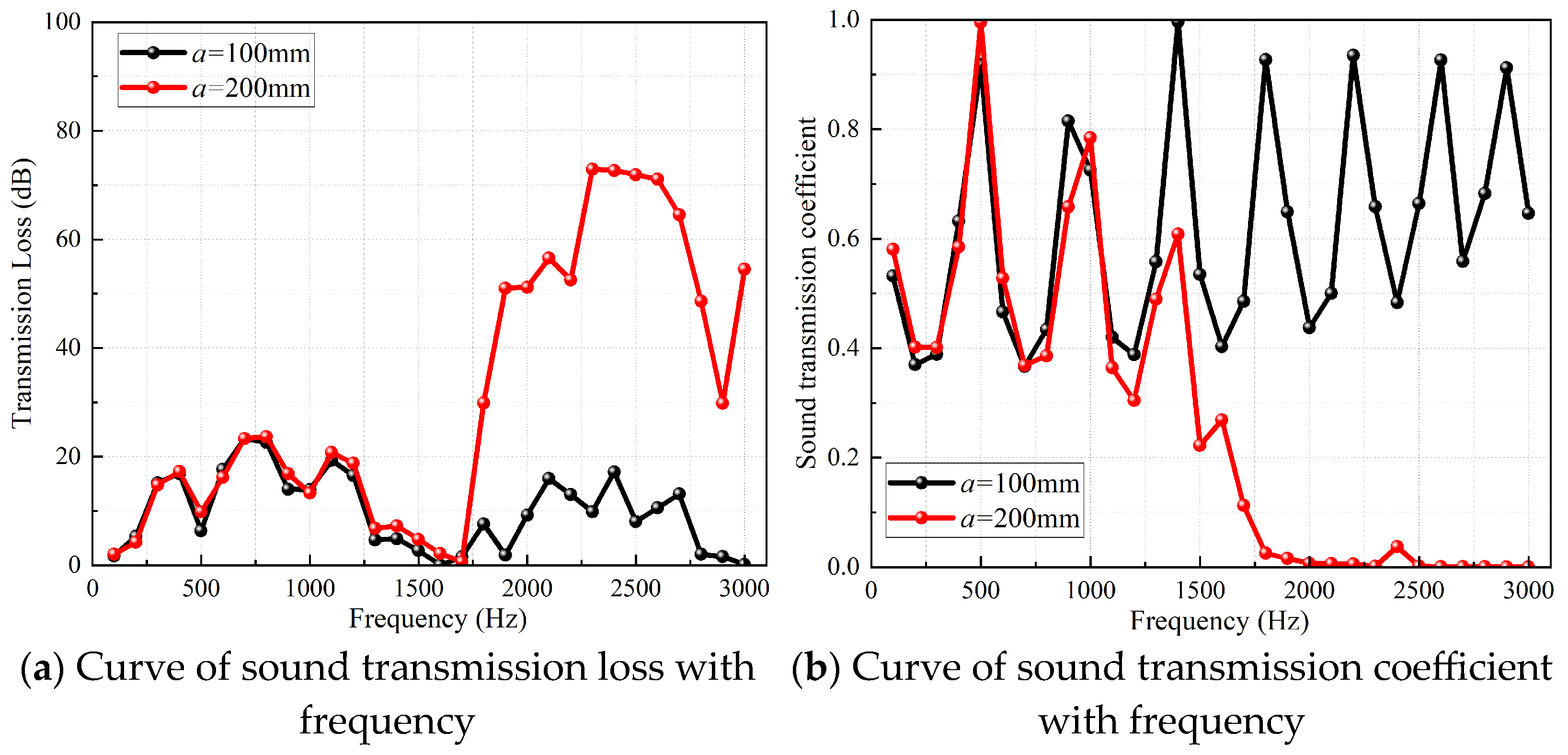










| Structural Type | Level Set Equations Representing the Co-Continuous Cubic Network Structures |
|---|---|
| Gyroid | |
| Schwarz P | |
| Split P | |
| Schwarz D | |
| where | represent spatial coordinates; a represents the TPMS unit cell size; C represents the constant controlling the surface offset of the TPMS unit cell |
| Frequency | FEM | Gyroid | Schwarz P | Split P | Schwarz D |
|---|---|---|---|---|---|
| 100~3000 Hz | 39.22 | 33.32 | 78.49 | 32.21 | 30.44 |
| 100~1600 Hz | 31.93 | 27.65 | 29.39 | 28.50 | 27.99 |
| 1700~3000 Hz | 38.32 | 31.94 | 78.49 | 29.81 | 26.79 |
Disclaimer/Publisher’s Note: The statements, opinions and data contained in all publications are solely those of the individual author(s) and contributor(s) and not of MDPI and/or the editor(s). MDPI and/or the editor(s) disclaim responsibility for any injury to people or property resulting from any ideas, methods, instructions or products referred to in the content. |
© 2025 by the authors. Licensee MDPI, Basel, Switzerland. This article is an open access article distributed under the terms and conditions of the Creative Commons Attribution (CC BY) license (https://creativecommons.org/licenses/by/4.0/).
Share and Cite
Liu, J.; Zhang, W.; Xu, R.; Peng, T. Research on Sound Transmission Characteristics of Shell-And-Tube Heat Exchangers Based on TPMS Structures. Appl. Sci. 2025, 15, 12098. https://doi.org/10.3390/app152212098
Liu J, Zhang W, Xu R, Peng T. Research on Sound Transmission Characteristics of Shell-And-Tube Heat Exchangers Based on TPMS Structures. Applied Sciences. 2025; 15(22):12098. https://doi.org/10.3390/app152212098
Chicago/Turabian StyleLiu, Jinwei, Wenwen Zhang, Rongwu Xu, and Tao Peng. 2025. "Research on Sound Transmission Characteristics of Shell-And-Tube Heat Exchangers Based on TPMS Structures" Applied Sciences 15, no. 22: 12098. https://doi.org/10.3390/app152212098
APA StyleLiu, J., Zhang, W., Xu, R., & Peng, T. (2025). Research on Sound Transmission Characteristics of Shell-And-Tube Heat Exchangers Based on TPMS Structures. Applied Sciences, 15(22), 12098. https://doi.org/10.3390/app152212098





